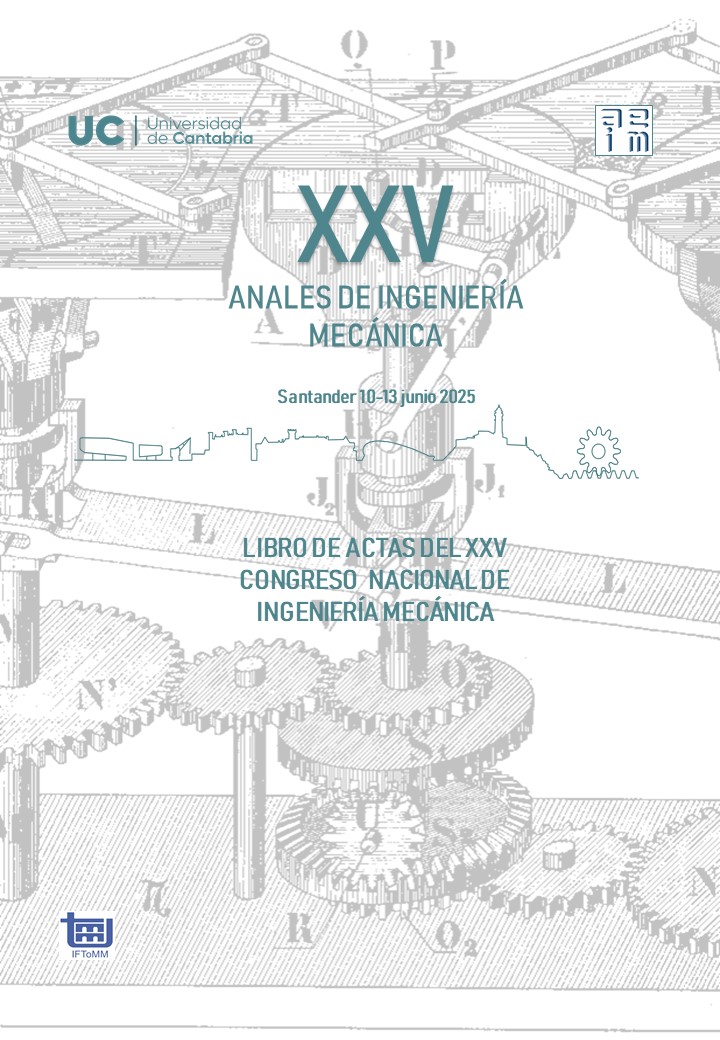Caracterización mecánica de hidrogeles mediante ensayos de nanoindentación
Contenido principal del artículo
Resumen
Los materiales blandos se caracterizan por presentar comportamientos mecánicos complejos, en muchas ocasiones asociados a no linealidad y dependencia del tiempo. Los ensayos de indentación son una técnica experimental que permite caracterizar mecánicamente un material a diferentes escalas, lo que hace posible identificar mecanismos físicos asociados al comportamiento de los materiales blandos. Cuando la escala del ensayo es muy pequeña y entra en el rango de los nanómetros, los fenómenos de adhesión pueden ser muy relevantes y deben ser tenidos en cuenta para extraer las propiedades mecánicas del material. Los modelos mecánicos del continuo más conocidos (Hertz, Johnson-Kendall-Roberts, etc.) suelen estar basados en las hipótesis de elasticidad, linealidad e independencia del tiempo. Para poder aplicar estos modelos a materiales blandos es necesario combinarlos con análisis viscoelásticos.
En este trabajo se presenta una metodología de análisis de los resultados de ensayos de nanoindentación en materiales blandos que utiliza el principio de correspondencia para determinar la función de relajación viscoelástica y la energía de adhesión. A partir de las curvas fuerza-desplazamiento medidas en ensayos de nanoindentación se aplica la transformada de Laplace-Carson para convertir el problema viscoelástico real en un problema elástico equivalente. En el espacio transformado se aplican los modelos de contacto de continuo y se extraen las propiedades objetivo al deshacer la transformada de Laplace-Carson.
Esta metodología se ha utilizado para caracterizar diversos hidrogeles con aplicaciones en la ingeniería biomédica y en la ingeniería de tejidos.
Detalles del artículo

Esta obra está bajo una licencia internacional Creative Commons Atribución-NoComercial-CompartirIgual 4.0.
CC BY-NC-SA 4.0)
El lector puede compartir, copiar y redistribuir el material en cualquier medio o formato, siempre y cuando cumpla con las siguientes condiciones:
-
Atribución (BY): Debe dar crédito adecuado al autor original, proporcionando un enlace a la licencia y señalando si se han realizado cambios.
-
No Comercial (NC): No puede utilizar el material con fines comerciales. Esto significa que no puede venderlo ni obtener ganancias directas de su uso.
-
Compartir Igual (SA): Si adapta, transforma o construye sobre el material, debe distribuir sus contribuciones bajo la misma licencia que el original.
Recuerda que esta licencia no afecta los derechos legales del autor, como el derecho moral o las excepciones de uso justo.
Citas
Gong JP, Katsuyama Y, Kurokawa T, Osada Y. Double-network hydrogels with extremely high mechanical strength, Adv Mater 2003; 15: 1155–8. https://doi.org/10.1002/adma.200304907
Chen RS, Gao M, Chu D, Cheng W, Lu Y. Self-powered hydrogel wearable bioelectronics, Nano Energy 2024; 128 Part B: 109960. https://doi.org/10.1016/j.nanoen.2024.109960
Park CS, Kang YW, Na H, Sun JY. Hydrogels for bioinspired soft robots. Progress in Polymer Science 2024; 150: 101791. https://doi.org/10.1016/j.progpolymsci.2024.101791
The mechanics of hydrogels. Mechanical properties, testing and applications. H Li and V Silberschmidt editors. Elsevier, 2022.
Selby A, Maldonado-Codina C, Derby B. Influence of specimen thickness on the nanoindentation of hydrogels: Measuring the mechanical properties of soft contact lenses. Journal of the Mechanical Behavior of Biomedical Materials 2014; 35: 144 – 156. http://dx.doi.org/10.1016/j.jmbbm.2013.11.023
Toohey KS, Kalyanam S, Palaniappan J, Insana MF. Indentation analysis of biphasic viscoelastic hydrogels. Mechanics of materials 2016; 92: 175-184. http://dx.doi.org/10.1016/j.mechmat.2015.09.010
Cabeza-Gil I, Calvo B, Rico A, Reinhards-Hervás C, Rodríguez J. Mechanical characterisation of hydrophobic and hydrophilic acrylates used in intraocular lenses through depth sensing indentation. Journal of the Mechanical Behavior of Biomedical Materials 2022; 126: 104997. https://doi.org/10.1016/j.jmbbm.2021.104997
Cuenot S, Gélébart P, Sinquin C, Colliec-Jouault S, Zykwinsk A. Mechanical relaxations of hydrogels governed by their physical or chemical crosslinks. Journal of the Mechanical Behavior of Biomedical Materials 2022; 133: 105343. https://doi.org/10.1016/j.jmbbm.2022.105343
Pragnere S, Courtial EJ, Dubreuil F, Errazuriz-Cerda E, Marquette C, Petiot E, Pailler-Mattei C. Tuning viscoelasticity and stiffness in bioprinted hydrogels for enhanced 3D cell culture: a multi-scale mechanical analysis. Journal of the Mechanical Behavior of Biomedical Materials 2024; 159: 106696. https://doi.org/10.1016/j.jmbbm.2024.1056696
Esteki MH, Alemrajabi AA, Hall CM, Sheridan GK, Azadi M, Moeendarbary E. A new framework for characterization of poroelastic materials using indentation, Acta Biomaterialia 2020; 102: 138-148. https://doi.org/10.1016/j.actbio.2019.11.010
Reinhards–Hervas C, Rico A, Rodríguez J. Crosslinker concentration effect on the poroviscoelastic relaxation of polyacrylamide hydrogels using depth-sensing indentation. Polym Test 2021; 100: 107265. https://doi.org/10.1016/j.polymertesting.2021.107265
Reinhards-Hervás, C. Hidrogeles de poliacrilamida: comportamiento mecánico y fractura. PhD thesis, 2024. Universidad Rey Juan Carlos.
Hertz H. Über die berührung fester elastischer körper (on the contact of elastic solids). Journal für die reine und angewandte mathematic 1881; .92: 156–171.
Johnson KL, Kendall K, Roberts A. Surface energy and the contact of elastic solids, Proceedings of the Royal Society A: Mathematical, Physical and Engineering Sciences 1971; 324 (1558): 301-313. https://doi.org/10.1098/rspa.1971.0141
Christensen R. Theory of Viscoelasticity, An Introduction. 2nd Edition - November 12, 2012.
C. Reinhards, A.J. Cano, A. Rico, A. Salazar, J. Rodríguez, Fracture resistance of polyacrylamide-alginate hydrogels. Eng Fract Mech 295 (2024): 109812. https://doi.org/10.1016/j.engfracmech.2023.109812
B. Davies, B. Martin, Numerical inversion of the laplace transform: a survey and comparison of methods, Journal of Computational Physics 33 [1] (1979): 1-32. https://doi.org/10.1016/0021-9991(79)90025-1
C. Donolato, Analytical and numerical inversion of the Laplace–Carson transform by a differential method, Computer Physics Communications 145 (2002) 298–309. https://doi.org/10.1016/S0010-4655(02)00281-3
Yang Lai, Y. Hu, The relation between adhesion properties and network properties of hydrogels: A study based on an indentation adhesion method. Mechanics of Materials 159 (2021): 103877. https://doi.org/10.1016/j.mechmat.2021.103877
Y. Lai, D. He, Y. Hu, Indentation adhesion of hydrogels over a wide range of length and time scales. Extreme Mechanics Letters 31 (2019): 100540. https://doi.org/10.1016/j.eml.2019.100540
Z. Zhou, J. Lei, Z. Liu, Effect of water content on physical adhesion of polyacrylamide hydrogels. Polymer 246 (2022): 124730. https://doi.org/10.1016/j.polymer.2022.124730
X. Ni, Z. Yang, J. Li, Scaling Behavior of Fracture Properties of Tough Adhesive Hydrogels. ACS Macro Lett. 2021, 10, 180−185. https://dx.doi.org/10.1021/acsmacrolett.0c00854.
Y. Hu, Z. Suo, Viscoelasticity and poroelasticity in elastomeric gels. Acta Mechanica Solida Sinica, Vol. 25, No. 5, October, 2012. https://doi.org/10.1016/S0894-9166(12)60039-1.

